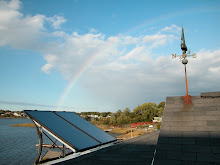Solar thermal means using the energy from the sun to make hot water. There are two types of solar thermal collectors used in residential applications, flat plate collectors and evacuated tube collectors. I have an hour long presentation that I do on this topic, but I'll keep it brief here.
Flat plate collectors are the same type of collectors commonly installed in the 70's and 80's. They haven't reinvented the wheel. They are basically the same as they were then, but with better insulation and more efficient absorbers. They consist of a 4 ft. by 10 ft. heat collection box (smaller sizes are available) with a series of pipes encased within it beneath a glass cover. These collectors can resemble skylights. As fluid (usually a glycol mix or plain water) flows through the collector it is heated by the sun. The heat of the fluid is transferred to the hot water storage tank. Flat plate collectors are very much affected by the ambient air temperature. They will perform much better in warm conditions than in cold conditions.
Evacuated tube collectors have become increasingly more popular over the last 4-5 years. These collectors use absorber plates on heat tubes to collect solar energy. There can be anywhere from 16 to 30 evacuated tubes in a collector. There is a small amount of water within the tube that boils. The steam rises up the tube and transfers it's energy to a glycol solution in a header assembly which then transfers the heat to the hot water tank. When the steam cools and condenses, it drips back down the tube to repeat the process. The heat tube is encased in a glass vacuum tube. The insulating characteristics of the vacuum shields the heat tube from ambient conditions. Because of this, evacuated tube collectors perform nearly the same in warm conditions as in cold conditions.
The question I hear most is, "Well, which one is better?" It really depends on where you are and what you want to heat. Here, where I am subjected to the chill of the Mid Atlantic winters, I have two evacuated tube collectors, a 24 tube and a 30 tube, heating my hot water as well as the radiant heat and growing table heat for my wife's greenhouse/potting shed. If I was heating a pool in the warm summer months, I'd be using flat plate collectors.
Saturday, July 24, 2010
Wednesday, January 20, 2010
Energy Raising
There is a new initiative floating around the solar industry called "energy raising." The concept is based on the well-known barn raisings utilized by the Amish. Many hands make for light work. The solar version uses the same idea of neighbors helping neighbors, but instead of raising a barn, a solar thermal hot water system is "raised." Volunteers split into groups to assist in installing the evacuated tubes and rack, the piping and other components. The host of the energy raising pays it forward by helping out on other installations. Participating in an energy raising is a great way to lower the cost of a solar thermal installation. Some professional help will be required in regards to connecting the water tank to the plumbing and electrical systems. A group in Plymouth, NH has pioneered the energy raising concept, but there are other groups that have followed suit. I am a proud contributor to the energy raising efforts of the DFA Task Force for Energy, Environment and Sustainability in Gettysburg.
Wednesday, January 13, 2010
Efficient Seed Propagation Lights
My wife operates a small Certified Naturally Grown farm. She calls me her "farm hand." I guess the title fits as my responsibilities include those similar to what a farm hand would do; rototilling, bark chipping, fetching compost and building hoop houses and cold frames. Since I don't get paid for my services (other that by delicious "locally grown" veggies) I need a title. I don't care too much for the title she gave me, so I am to be known as the self-anointed Director of Energy Consciousness. She has decided to implement lighting for seed propagation. I am leery of using the term "grow lights" in fear of ending up on some DEA watch list, but that is what they are. After much research on lighting of this sort, I have determined that a mix of T5, T8 and T12 fluorescent lights will serve her best. The factors I considered most important were lumens per watt, cost and availability and environmental impact. T5 lights give off more light per watt and are more environmentally conscious in regards to mercury, but they are expensive and not available locally and would have to be ordered. Fortunately, she has a 2' T5 "sunlight" lamp which I modified to be used for her intended purpose. Since we have some older 4' T12 lights, I felt is was best to modify them with reflectors and mount them over a growing table. Their light output per watt is considerably lower than the newer T5's and T8's, but I felt it was best to use them until the end of their lives to avoid prematurely having to contend with the associated mercury issues, plus there was no expense involved. The remaining lights in the growing system are T8 lights. The light output per watt is close to the T5's and are readily available at the local home improvement center. I bought some Energy Star rated 4' T8 fluorescent shop lights with hanging chains and a power cord for less than $10 each. The 32 watt bulbs produce 20,000 lumens. I mixed some 5,000K "sunlight" bulbs with some 6,500K "daylight" bulbs to average the 5,500K needed for optimum growing with a suitable blend of light in the blue and red ranges. Now I just have to build a growing rack to hold the new lights. Oh wait, that is something a farm hand does...
Subscribe to:
Posts (Atom)
